Change of Human Footprint in China and Its Implications for Carbon Dioxide (CO2) Emissions
Abstract
1. Introduction
2. Methods and Data
2.1. Overview
2.2. Land-Use Cover
2.3. Roads and Railways
2.4. Population Density
2.5. Grazing Density
2.6. Night-Time Lights
2.7. CO2 Fluxes
2.8. Statistical Analyses
3. Results
3.1. Spatio-Temporal Pattern of Human Footprint in China
3.2. Spatio-Temporal Dynamics of CO2 Emission Fluxes in China
3.3. Correlations between CO2 Emissions and Human Pressures
4. Discussion
4.1. Characteristics of Human Pressures in China
4.2. CO2 Emissions in China
4.3. Impacts of Human Pressures on CO2 Emissions
5. Conclusions
Supplementary Materials
Author Contributions
Funding
Data Availability Statement
Conflicts of Interest
References
- Corlett, R.T. The anthropocene concept in ecology and conservation. Trends Ecol. Evol. 2015, 30, 36–41. [Google Scholar] [CrossRef] [PubMed]
- Watson, E.J.; Venter, O. Mapping the continuum of humanity’s footprint on land. One Earth 2019, 1, 175–180. [Google Scholar] [CrossRef]
- Zhang, L.; Xiong, L.; Li, J.; Huang, X. Long-term changes of nutrients and biocenoses indicating the anthropogenic influences on ecosystem in Jiaozhou Bay and Daya Bay, China. Mar. Pollut. Bull. 2021, 168, 112406. [Google Scholar] [CrossRef] [PubMed]
- Grizzetti, B.; Pistocchi, A.; Liquete, C.; Udias, A.; Bouraoui, F.; van de Bund, W. Human pressures and ecological status of European rivers. Sci. Rep. 2017, 7, 205. [Google Scholar] [PubMed]
- Tilman, D.; Lehman, C. Human-caused environmental change: Impacts on plant diversity and evolution. Proc. Natl. Acad. Sci. USA 2001, 98, 5433–5440. [Google Scholar] [CrossRef]
- Marques, A.; Martins, I.S.; Kastner, T.; Plutzar, C.; Theurl, M.C.; Eisenmenger, N.; Huijbregts, M.A.J.; Wood, R.; Stadler, K.; Bruckner, M.; et al. Increasing impacts of land use on biodiversity and carbon sequestration driven by population and economic growth. Nat. Ecol. Evol. 2019, 3, 628–637. [Google Scholar]
- Zandalinas, S.I.; Fritschi, F.B.; Mittler, R. Global warming, climate change, and environmental pollution: Recipe for a multifactorial stress combination disaster. Trends Plant Sci. 2021, 26, 588–599. [Google Scholar] [CrossRef]
- Mazdiyasni, O.; AghaKouchak, A. Substantial increase in concurrent droughts and heatwaves in the United States. Proc. Natl. Acad. Sci. USA 2015, 112, 11484–11489. [Google Scholar]
- Noyes, P.D.; McElwee, M.; Miller, H.D.; Clark, B.W.; Van Tiem, L.A.; Walcott, K.C.; Erwin, K.N.; Levin, E.D. The toxicology of climate change: Environmental contaminants in a warming world. Environ. Int. 2009, 35, 971–986. [Google Scholar] [CrossRef]
- du Pont, Y.R.; Meinshausen, M. Warming assessment of the bottom-up Paris Agreement emissions pledges. Nat. Commun. 2018, 9, 4810. [Google Scholar]
- Editorials. Accesses Net-zero carbon pledges must be meaningful to avert climate disaster. Nature 2021, 592, 8. [Google Scholar] [CrossRef]
- FAO (Food and Agriculture Organization of the United Nations). FAOSTAT. 2019. Available online: http://faostat.fao.org/ (accessed on 1 January 2022).
- Raupach, M.R.; Marland, G.; Ciais, P.; Le Quéré, C.; Canadell, J.G.; Klepper, G.; Field, C.B. Global and regional drivers of accelerating CO2 emissions. Proc. Natl. Acad. Sci. USA 2007, 104, 10288–10293. [Google Scholar] [CrossRef]
- Ibisch, P.L.; Hoffmann, M.T.; Kreft, S.; Pe’Er, G.; Kati, V.; Biber-Freudenberger, L.; DellaSala, D.A.; Vale, M.M.; Hobson, P.R.; Selva, N. A global map of roadless areas and their conservation status. Science 2016, 354, 1423–1427. [Google Scholar] [CrossRef]
- Harris, N.L.; Brown, S.; Hagen, S.C.; Saatchi, S.S.; Petrova, S.; Salas, W.; Hansen, M.C.; Potapov, P.V.; Lotsch, A. Baseline map of carbon emissions from deforestation in tropical regions. Science 2012, 336, 1573–1576. [Google Scholar] [CrossRef]
- Haddad, N.M.; Brudvig, L.A.; Clobert, J.; Davies, K.F.; Gonzalez, A.; Holt, R.D.; Lovejoy, T.E.; Sexton, J.O.; Austin, M.P.; Collins, C.D.; et al. Habitat fragmentation and its lasting impact on Earth’s ecosystems. Sci. Adv. 2015, 1, e1500052. [Google Scholar] [CrossRef]
- Henders, S.; Persson, U.M.; Kastner, T. Trading forests: Land-use change and carbon emissions embodied in production and exports of forest-risk commodities. Environ. Res. Lett. 2015, 10, 125012. [Google Scholar] [CrossRef]
- Mcgowan, P.J.K. Mapping the terrestrial human footprint. Nature 2016, 537, 172–173. [Google Scholar] [CrossRef]
- Mi, Z.; Wei, Y.-M.; Wang, B.; Meng, J.; Liu, Z.; Shan, Y.; Liu, J.; Guan, D. Socioeconomic impact assessment of China’s CO2 emissions peak prior to 2030. J. Clean. Prod. 2017, 142, 2227–2236. [Google Scholar] [CrossRef]
- Pflugmann, F.; Blasio, N.D. The geopolitics of renewable hydrogen in low-carbon energy markets. Geopolit. Hist. Int. Relat. 2020, 12, 9–44. [Google Scholar]
- Li, X.; Huang, C.; Zhan, S.; Wu, Y. The carbon emission reduction effect of city cluster—Evidence from the Yangtze River Economic Belt in China. Energies 2022, 15, 6210. [Google Scholar] [CrossRef]
- Labzovskii, L.D.; Mak, H.W.L.; Kenea, S.T.; Rhee, J.S.; Lashkari, A.; Li, S.; Goo, T.Y.; Oh, Y.S.; Byun, Y.H. What can we learn about effectiveness of carbon reduction policies from interannual variability of fossil fuel CO2 emissions in East Asia? Environ. Sci. Policy 2019, 96, 132–140. [Google Scholar] [CrossRef]
- Sanderson, E.W.; Jaiteh, M.; Levy, M.A.; Redford, K.H.; Wannebo, A.V.; Woolmer, G. The human footprint and the last of the wild. Bioscience 2002, 52, 172–173. [Google Scholar] [CrossRef]
- Venter, O.; Sanderson, E.W.; Magrach, A.; Allan, J.R.; Beher, J.; Jones, K.R.; Possingham, H.P.; Laurance, W.F.; Wood, P.; Fekete, B.M.; et al. Sixteen years of change in the global terrestrial human footprint and implications for biodiversity conservation. Nat. Commun. 2016, 7, 12558. [Google Scholar] [CrossRef] [PubMed]
- Halpern, B.S.; Walbridge, S.; Selkoe, K.A.; Kappel, C.V.; Micheli, F.; D’Agrosa, C.; Bruno, J.F.; Casey, K.S.; Ebert, C.; Fox, H.E.; et al. A global map of human impact on marine ecosystems. Science 2008, 319, 948–952. [Google Scholar] [CrossRef] [PubMed]
- Mammides, C. A global assessment of the human pressure on the world’s lakes. Global Environ. Chang. 2020, 63, 102084. [Google Scholar] [CrossRef]
- Peters, G.; Andrew, R.; Boden, T.; Canadell, J.G.; Ciais, P.; Le Quéré, C.; Marland, G.; Raupach, M.R.; Wilson, C. The challenge to keep global warming below 2 °C. Nat. Clim. Chang. 2012, 2, 2–4. [Google Scholar] [CrossRef]
- Chiu, C.-C.; Château, P.-A.; Lin, H.-J.; Chang, Y.-C. Modeling the impacts of coastal land use changes on regional carbon balance in the Chiku coastal zone, Taiwan. Land Use Policy 2019, 87, 104079. [Google Scholar] [CrossRef]
- Doney, S.C. The Growing Human Footprint on Coastal and Open-Ocean Biogeochemistry. Science 2010, 5985, 1512–1516. [Google Scholar] [CrossRef]
- Findell, K.L.; Berg, A.; Gentine, P.; Krasting, J.P.; Lintner, B.R.; Malyshev, S.; Santanello, J.A., Jr.; Shevliakova, E. The impact of anthropogenic land use and land cover change on regional climate extremes. Nat. Commun. 2017, 8, 989. [Google Scholar] [CrossRef]
- Havlík, P.; Valin, H.; Herrero, M.; Obersteiner, M.; Schmid, E.; Rufino, M.C.; Mosnier, A.; Thornton, P.K.; Böttcher, H.; Conant, R.T.; et al. Climate change mitigation through livestock system transitions. Proc. Natl. Acad. Sci. USA 2014, 111, 3709–3714. [Google Scholar] [CrossRef]
- Hong, C.; Burney, J.A.; Pongratz, J.; Nabel, J.E.M.S.; Mueller, N.D.; Jackson, R.B.; Davis, S.J. Global and regional drivers of land-use emissions in 1961–2017. Nature 2021, 589, 554–561. [Google Scholar] [CrossRef]
- Houghton, R.A.; House, J.I.; Pongratz, J.; Van Der Werf, G.R.; DeFries, R.S.; Hansen, M.C.; Le Quéré, C.; Ramankutty, N. Carbon emissions from land use and land-cover change. Biogeosciences 2012, 9, 5125–5142. [Google Scholar] [CrossRef]
- Lai, L.; Huang, X.; Yang, H.; Chuai, X.; Zhang, M.; Zhong, T.; Chen, Z.; Chen, Y.; Wang, X.; Thompson, J.R. Carbon emissions from land-use change and management in China between 1990 and 2010. Sci. Adv. 2016, 2, e1601063. [Google Scholar] [CrossRef]
- Din, S.U.; Mak, H.W.L. Retrieval of land-use/land cover change (LUCC) maps and urban expansion dynamics of Hyderabad, Pakistan via Landsat Datasets and support vector machine framework. Remote Sens. 2021, 13, 3337. [Google Scholar] [CrossRef]
- Arshad, S.; Kazmi, J.H.; Fatima, M.; Khan, N. Change detection of land cover/land use dynamics in arid region of Bahawalpur District, Pakistan. Appl. Geomat. 2022, 14, 387–403. [Google Scholar] [CrossRef]
- Meng, X.; Han, J. Roads, economy, population density, and CO2: A city-scaled causality analysis. Resour. Conserv. Recy. 2016, 128, 508–515. [Google Scholar] [CrossRef]
- Yeboah, G.; de Albuquerque, J.P.; Troilo, R.; Tregonning, G.; Perera, S.; Ahmed, S.; Ajisola, M.; Alam, O.; Aujla, N.; Azam, S.; et al. Analysis of Openstreetmap data quality at different stages of a participatory mapping process: Evidence from Slums in Africa and Asia. ISPRS Int. J. Geo-Inf. 2021, 10, 265. [Google Scholar] [CrossRef]
- Sugar, L.; Kennedy, C.; Leman, E. Greenhouse gas emissions from Chinese cities. J. Ind. Ecol. 2012, 16, 552–563. [Google Scholar] [CrossRef]
- Achour, H.; Belloumi, M. Investigating the causal relationship between transport infrastructure, transport energy consumption and economic growth in Tunisia. Renew. Sustain. Energy Rev. 2016, 56, 988–998. [Google Scholar] [CrossRef]
- Wang, X.; Meng, X.; Long, Y. Projecting 1 km-grid population distributions from 2020 to 2100 globally under shared socioeconomic pathways. Sci. Data 2022, 9, 563. [Google Scholar] [CrossRef]
- Huang, R.; Lv, G.; Chen, M.; Zhu, Z. CO2 emissions embodied in trade: Evidence for Hong Kong SAR. J. Clean. Prod. 2019, 239, 117918. [Google Scholar] [CrossRef]
- Da, W.; Xu, R.; Wang, Y.; Wang, Y.; Liu, Y.; Yao, T. Responses of CO2, CH4 and N2O fluxes to livestock exclosure in an alpine steppe on the Tibetan Plateau, China. Plant Soil 2012, 359, 45–55. [Google Scholar]
- Gaughan, A.E.; Oda, T.; Sorichetta, A.; Stevens, F.R.; Bondarenko, M.; Bun, R.; Krauser, L.; Yetman, G.; Nghiem, S.V. Evaluating nighttime lights and population distribution as proxies for mapping anthropogenic CO2 emission in Vietnam, Cambodia and Laos. Environ. Res. Commun. 2019, 1, 091006. [Google Scholar] [CrossRef] [PubMed]
- Shi, K.; Shen, J.; Wu, Y.; Liu, S.; Li, L. Carbon dioxide (CO2) emissions from the service industry, traffic, and secondary industry as revealed by the remotely sensed nighttime light data. Int. J. Digit. Earth 2021, 14, 1514–1527. [Google Scholar] [CrossRef]
- Bennett, M.M.; Smith, L.C. Advances in using multitemporal night-time lights satellite imagery to detect, estimate, and monitor socioeconomic dynamics. Remote Sens. Environ. 2017, 192, 176–197. [Google Scholar] [CrossRef]
- Chen, J.; Gao, M.; Cheng, S.; Hou, W.; Song, M.; Liu, X.; Liu, Y.; Shan, Y. County-level CO2 emissions and sequestration in China during 1997–2017. Sci. Data 2020, 7, 391. [Google Scholar] [CrossRef]
- Zhang, Y.; Lyu, M.; Yang, P.; Lai, D.Y.; Tong, C.; Zhao, G.; Li, L.; Zhang, Y.; Yang, H. Spatial variations in CO2 fluxes in a subtropical coastal reservoir of Southeast China were related to urbanization and land-use types. J. Environ. Sci. 2021, 109, 206–218. [Google Scholar] [CrossRef]
- Krivoruchko, K.; Gribov, A.; Krause, E. Multivariate areal interpolation for continuous and count data. Procedia Environ. Sci. 2011, 3, 14–19. [Google Scholar] [CrossRef]
- Pyšek, P.; Jarošík, V.; Hulme, P.E.; Kühn, I.; Wild, J.; Arianoutsou, M.; Bacher, S.; Chiron, F.; Didžiulis, V.; Essl, F.; et al. Disentangling the role of environmental and human pressures on biological invasions across Europe. Proc. Natl. Acad. Sci. USA 2010, 107, 12157–12162. [Google Scholar] [CrossRef]
- Meng, J.; Mi, Z.; Guan, D.; Li, J.; Tao, S.; Li, Y.; Feng, K.; Liu, J.; Liu, Z.; Wang, X.; et al. The rise of south–south trade and its effect on global CO2 emissions. Nat. Commun. 2018, 9, 1871. [Google Scholar] [CrossRef]
- West, P.C.; Gerber, J.S.; Engstrom, P.M.; Mueller, N.D.; Brauman, K.A.; Carlson, K.M.; Cassidy, E.S.; Johnston, M.; MacDonald, G.K.; Ray, D.K.; et al. Leverage points for improving global food security and the environment. Science 2014, 345, 325–328. [Google Scholar] [CrossRef]
- Bala, G.; Caldeira, K.; Wickett, M.; Phillips, T.J.; Lobell, D.B.; Delire, C.; Mirin, A. Combined climate and carbon cycle effects of large-scale deforestation. Proc. Natl. Acad. Sci. USA 2007, 104, 6550–6555. [Google Scholar] [CrossRef]
- Hansis, E.; Davis, S.J.; Pongratz, J. Relevance of methodological choices for accounting of land use change carbon fluxes. Glob. Biogeochem. Cycles 2015, 29, 1230–1246. [Google Scholar] [CrossRef]
- Shen, F.; Yang, L.; He, X.; Zhou, C.; Adams, J.M. Understanding the spatial-temporal variation of human footprint in Jiangsu Province, China, its anthropogenic and potential implications. Sci. Rep. 2020, 10, 13316. [Google Scholar] [CrossRef]
- Liu, Z.; Geng, Y.; Lindner, S.; Guan, D. Uncovering China’s greenhouse gas emission from regional and sectoral perspectives. Energy 2012, 45, 1059–1068. [Google Scholar] [CrossRef]
- Feng, K.; Hubacek, K.; Guan, D. Lifestyles, technology and CO2 emissions in China: A regional comparative analysis. Ecol. Econ. 2009, 69, 145–154. [Google Scholar] [CrossRef]
- Qin, H.; Huang, Q.; Zhang, Z.; Lu, Y.; Li, M.; Xu, L.; Chen, Z. Carbon dioxide emission driving factors analysis and policy implications of Chinese cities: Combining geographically weighted regression with two-step cluster. Sci. Total Environ. 2019, 684, 413–424. [Google Scholar] [CrossRef]
- Olivier, J.G.; Schure, K.M.; Peters, J.A.H.W. Trends in Global CO2 and Total Greenhouse Gas Emissions Summary of the 2017 Report; Netherlands Environmental Assessment Agency, PBL: The Hague, The Netherlands, 2019. [Google Scholar]
- Gregg, J.S. China: Emissions pattern of the world leader in CO2 emissions from fossil fuel consumption and cement production. Geophys. Res. Lett. 2008, 35, L08806. [Google Scholar] [CrossRef]
- Liu, Z.; Liang, S.; Geng, Y.; Xue, B.; Xi, F.; Pan, Y.; Zhang, T.; Fujita, T. Features, trajectories and driving forces for energy-related GHG emissions from Chinese mega cites: The case of Beijing, Tianjin, Shanghai and Chongqing. Energy 2012, 37, 245–254. [Google Scholar] [CrossRef]
- Liu, Z.; Davis, S.J.; Feng, K.; Hubacek, K.; Liang, S.; Anadon, L.D.; Chen, B.; Liu, J.; Yan, J.; Guan, D. Targeted opportunities to address the climate–trade dilemma in China. Nat. Clim. Chang. 2016, 6, 201–206. [Google Scholar] [CrossRef]
- CSC (China State Council). China’s 12th Five-Year Plan for Energy Development; CSC: Beijing, China, 2012. [Google Scholar]
- Moutinho, V.; Moreira, A.C.; Silva, P.M. The driving forces of change in energy related CO2 emissions in Eastern, Western, Northern and Southern Europe: The LMDI approach to decomposition analysis. Renew. Sust. Energ. Rev. 2015, 50, 1485–1499. [Google Scholar] [CrossRef]
- Adye, K.; Pearre, N.; Swan, L. Contrasting distributed and centralized photovoltaic system performance using regionally distributed pyranometers. Sol. Energy 2018, 160, 1–9. [Google Scholar] [CrossRef]
- Liu, F.; Lv, T. Assessment of geographical distribution of photovoltaic generation in China for a low carbon electricity transition. J. Clean. Prod. 2019, 212, 655–665. [Google Scholar] [CrossRef]
- Wei, W.; Wu, X.; Li, J.; Jiang, X.; Zhang, P.; Zhou, S.; Zhu, H.; Liu, H.; Chen, H.; Guo, J.; et al. Ultra-high voltage network induced energy cost and carbon emissions. J. Clean. Prod. 2018, 178, 276–292. [Google Scholar] [CrossRef]
- Li, Y.; Yi, B.-W.; Wang, Y. Can ultra-high voltage power transmission bring environmental and health benefits? an assessment in China. J. Clean. Prod. 2020, 178, 124296. [Google Scholar] [CrossRef]
- Wang, X.; Huang, L.; Daim, T.; Li, X.; Li, Z. Evaluation of China’s new energy vehicle policy texts with quantitative and qualitative analysis. Technol. Soc. 2021, 67, 101770. [Google Scholar] [CrossRef]
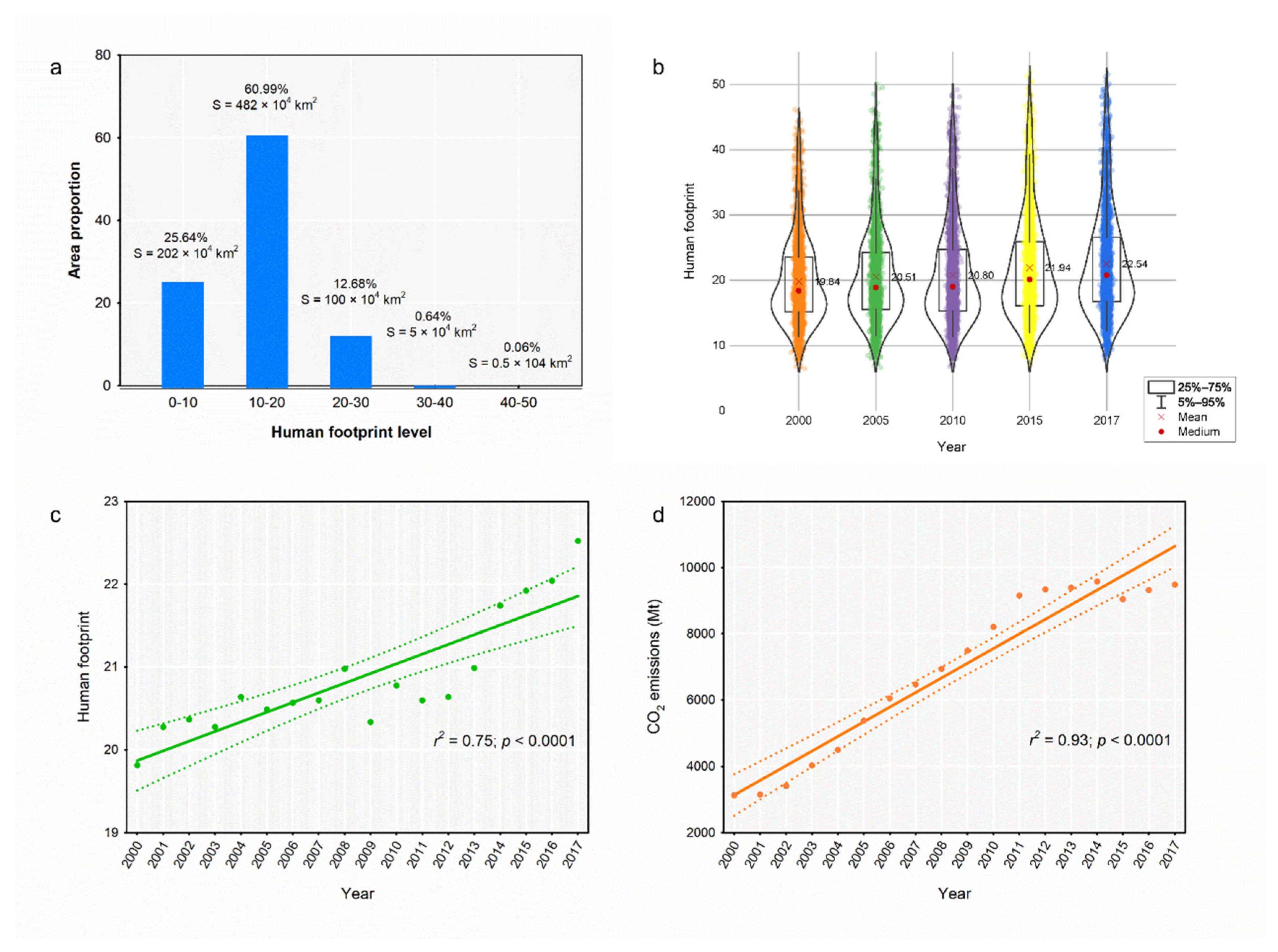
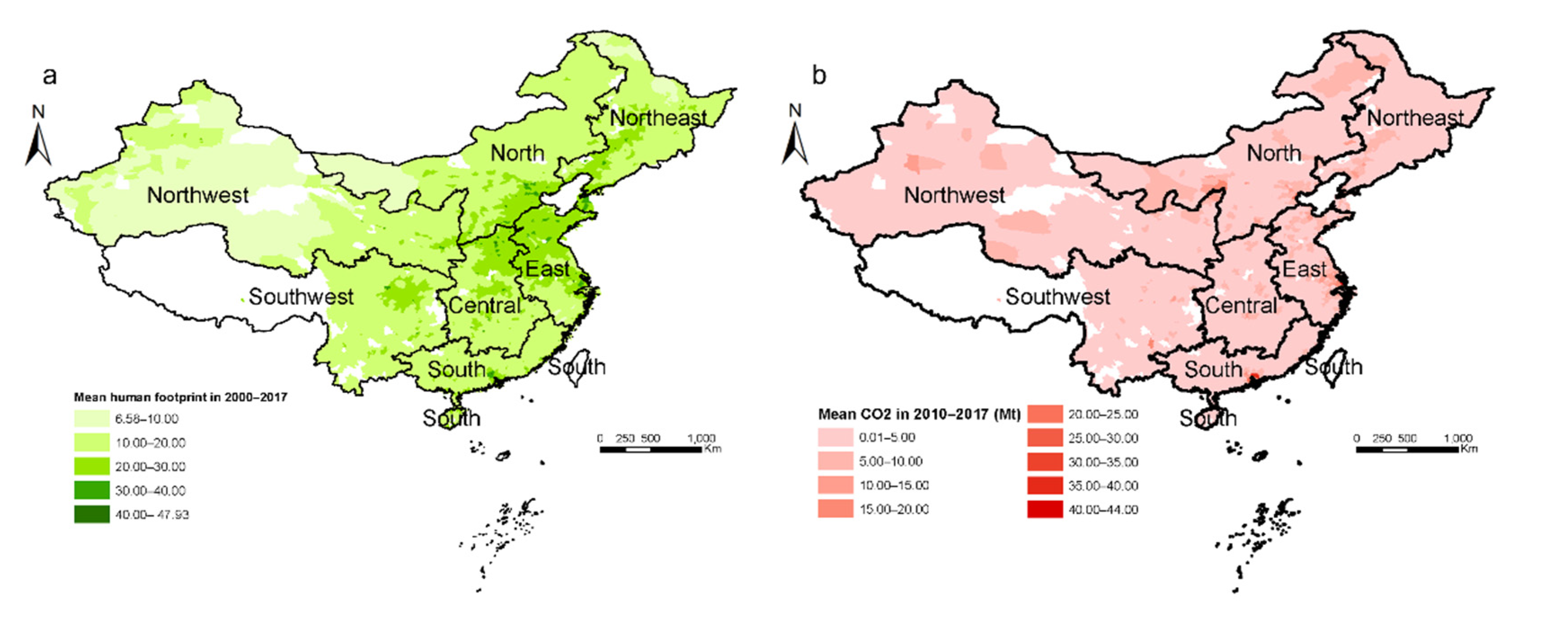

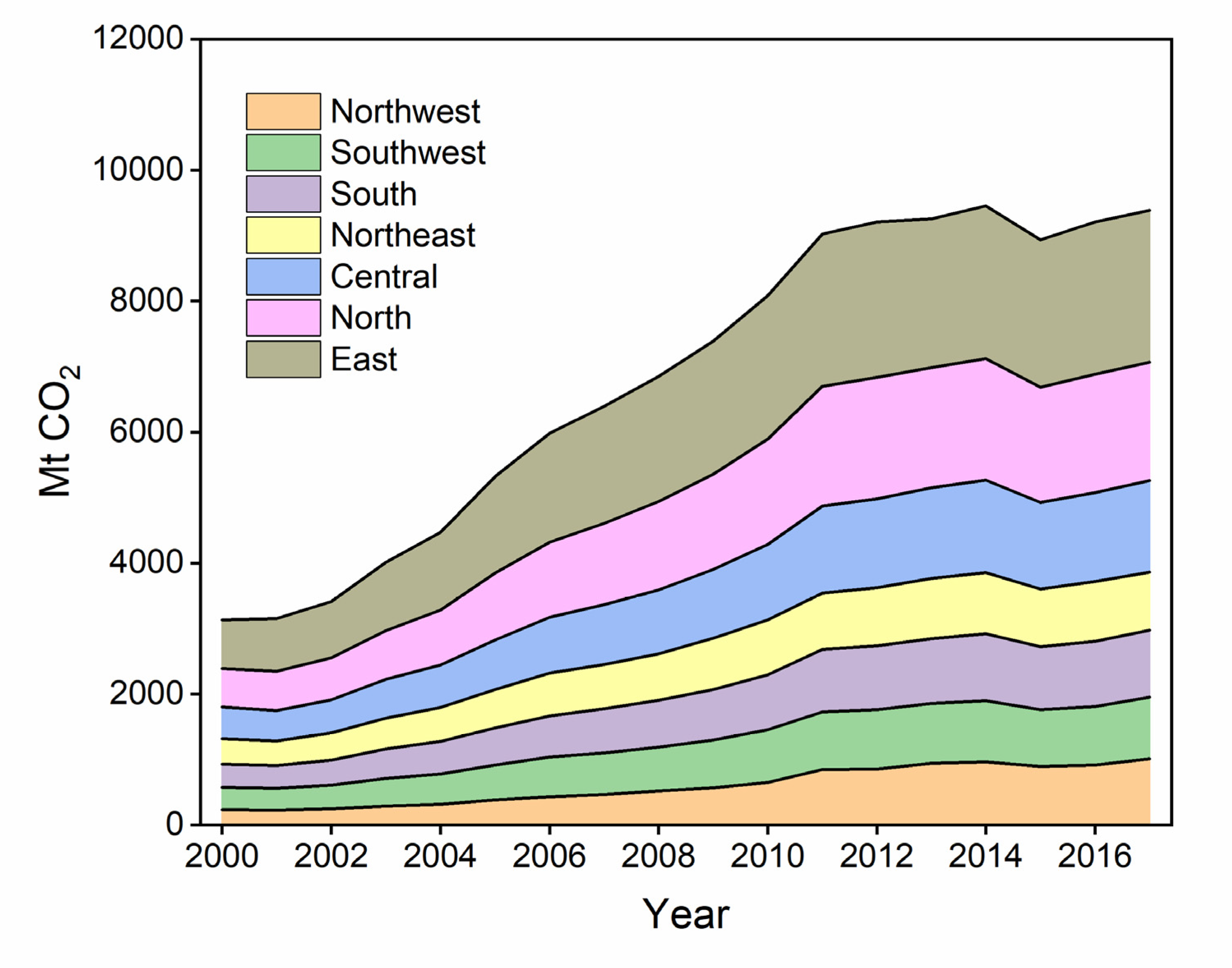
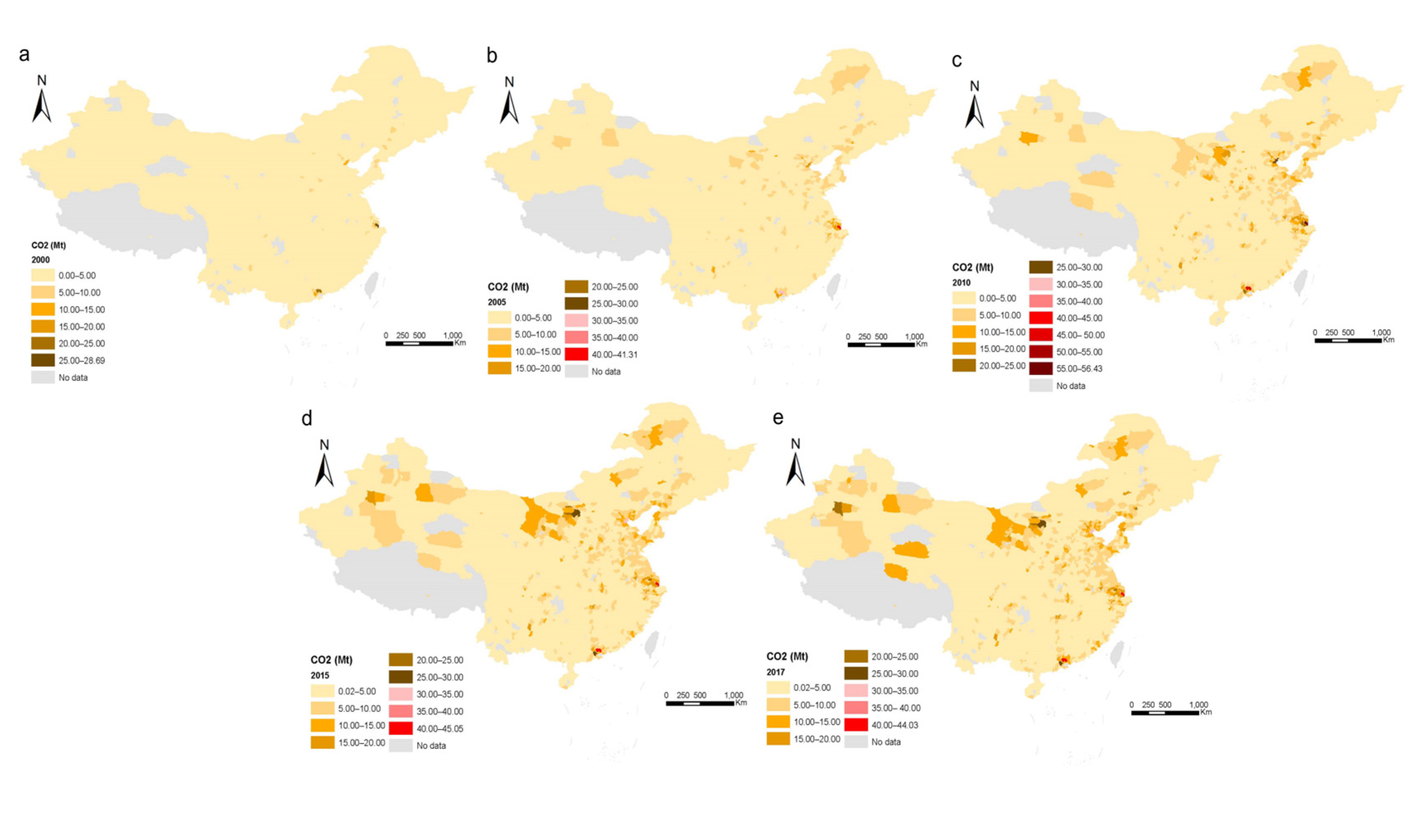
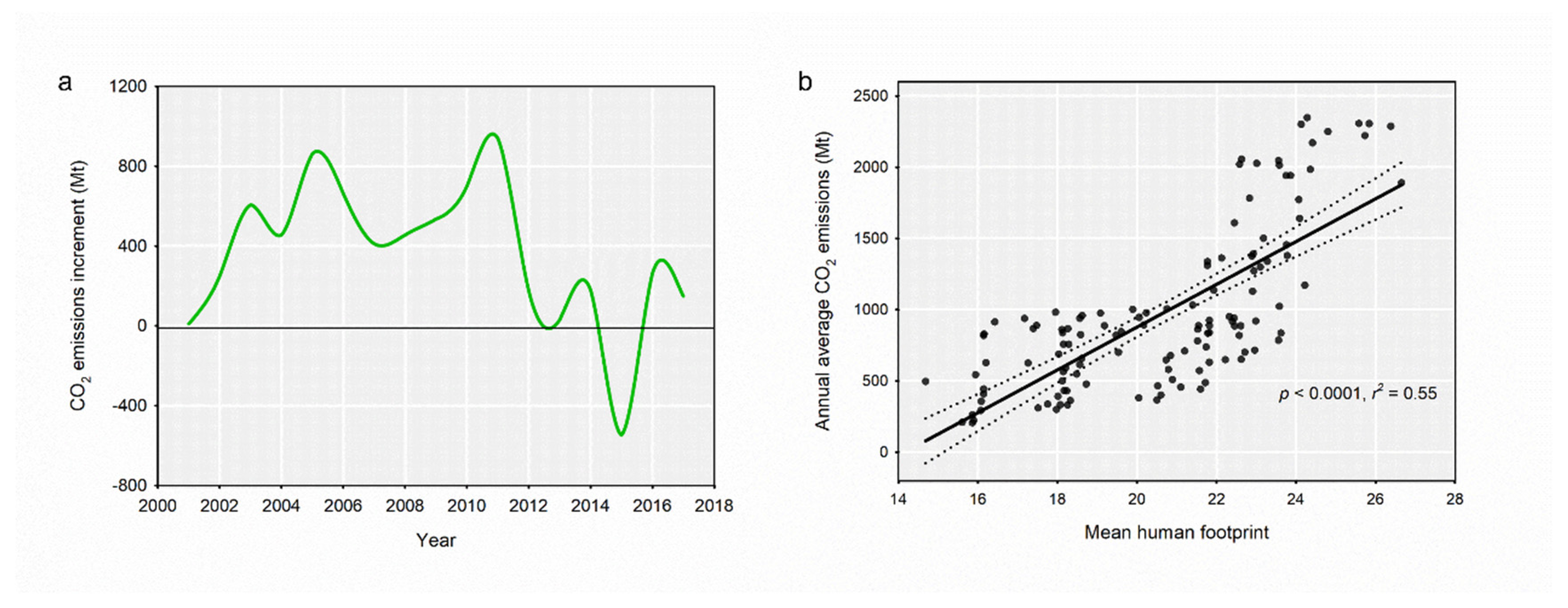
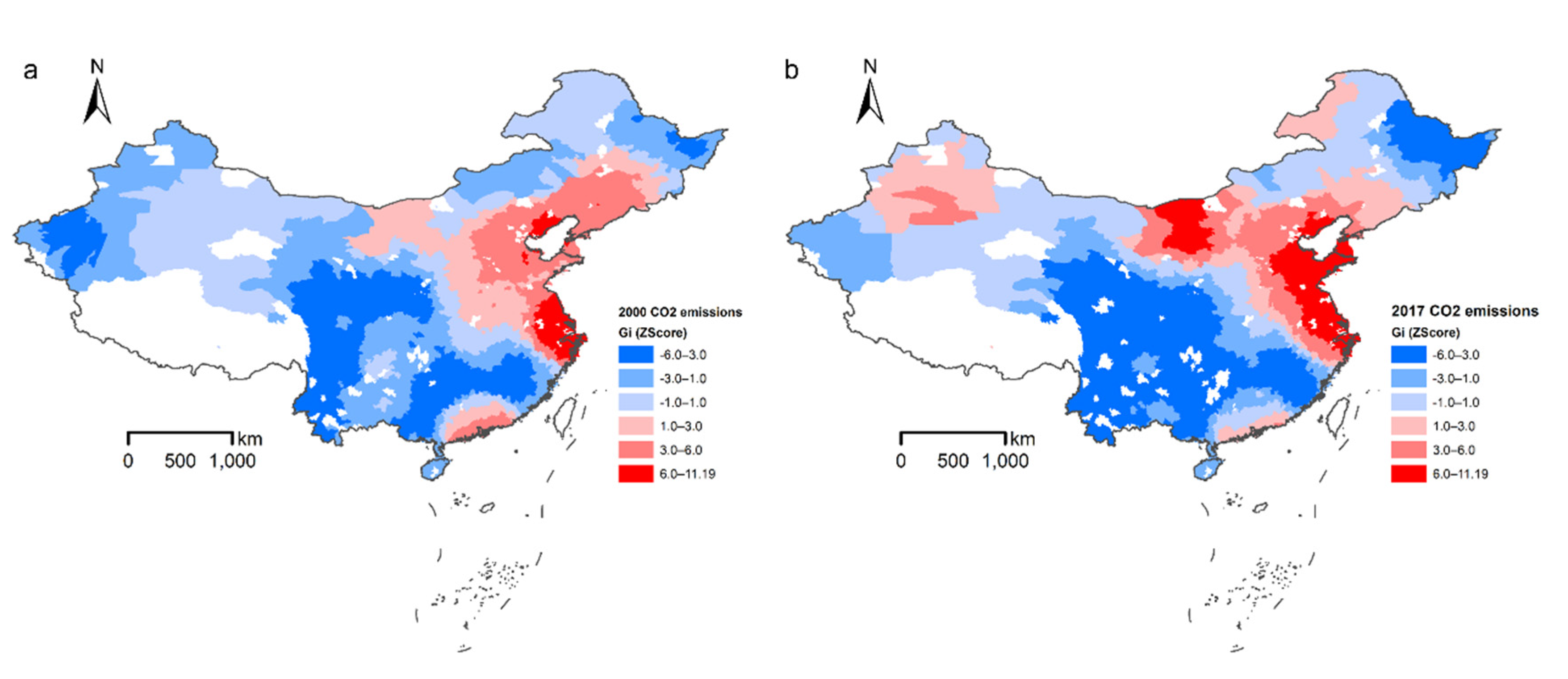
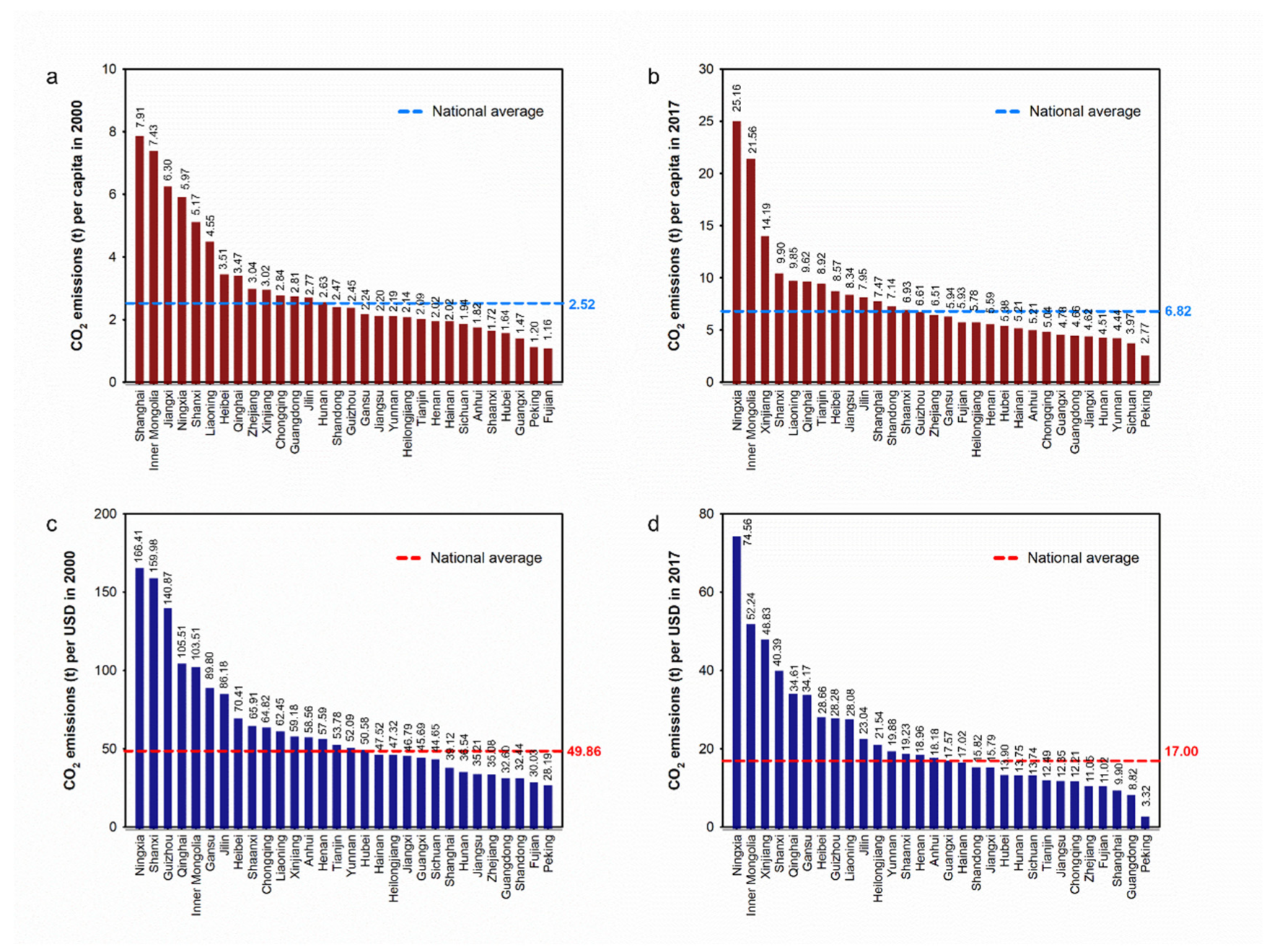
| Region/Human Footprint | Nationwide | North | South | Northeast | Northwest | Southwest | Central | East |
|---|---|---|---|---|---|---|---|---|
| 2000 | 19.84 | 22.22 | 17.75 | 20.04 | 15.60 | 17.51 | 21.10 | 22.96 |
| 2001 | 20.30 | 22.62 | 18.25 | 20.50 | 15.86 | 17.97 | 21.60 | 23.56 |
| 2002 | 20.39 | 22.71 | 18.32 | 20.60 | 15.89 | 18.07 | 21.72 | 23.62 |
| 2003 | 20.30 | 22.57 | 18.23 | 20.52 | 15.86 | 18.01 | 21.57 | 23.58 |
| 2004 | 20.66 | 22.99 | 18.72 | 20.89 | 16.07 | 18.16 | 21.82 | 24.22 |
| 2005 | 20.51 | 22.91 | 18.48 | 20.79 | 16.08 | 18.12 | 21.74 | 23.76 |
| 2006 | 20.59 | 22.94 | 18.56 | 20.73 | 16.14 | 18.14 | 21.78 | 24.09 |
| 2007 | 20.62 | 22.89 | 18.61 | 20.84 | 16.14 | 18.20 | 21.82 | 24.07 |
| 2008 | 21.00 | 23.18 | 19.53 | 21.20 | 14.68 | 17.26 | 22.32 | 26.65 |
| 2009 | 20.36 | 22.45 | 18.15 | 21.52 | 15.94 | 18.03 | 21.40 | 23.58 |
| 2010 | 20.80 | 22.83 | 18.58 | 21.82 | 16.20 | 18.28 | 21.93 | 24.41 |
| 2011 | 20.62 | 22.58 | 18.56 | 21.53 | 16.14 | 18.13 | 21.77 | 24.13 |
| 2012 | 20.66 | 22.63 | 18.62 | 21.55 | 16.15 | 18.11 | 21.77 | 24.28 |
| 2013 | 21.01 | 23.01 | 19.08 | 21.82 | 16.42 | 18.26 | 22.13 | 24.80 |
| 2014 | 21.76 | 23.56 | 19.89 | 22.44 | 17.17 | 19.18 | 22.92 | 25.58 |
| 2015 | 21.94 | 23.75 | 20.05 | 22.45 | 17.39 | 19.47 | 23.10 | 25.73 |
| 2016 | 22.06 | 23.86 | 20.23 | 22.40 | 17.47 | 19.60 | 23.28 | 25.84 |
| 2017 | 22.54 | 24.36 | 20.75 | 22.61 | 17.95 | 20.17 | 23.78 | 26.38 |
| Mean | 20.89 | 23.00 | 18.91 | 21.35 | 16.29 | 18.37 | 22.08 | 24.51 |
| Increment | 2.70 | 2.14 | 3.00 | 2.56 | 2.36 | 2.67 | 2.68 | 3.43 |
| Chang rate (%) | 13.60 | 9.63 | 16.87 | 12.79 | 15.10 | 15.22 | 12.70 | 14.93 |
| Region/CO2 (Mt) | Nationwide | North | South | Northeast | Northwest | Southwest | Central | East |
|---|---|---|---|---|---|---|---|---|
| 2000 | 3194.81 | 667.21 | 356.84 | 400.53 | 229.78 | 330.06 | 476.33 | 734.06 |
| 2001 | 3217.34 | 669.42 | 350.19 | 386.20 | 226.75 | 319.82 | 461.73 | 803.24 |
| 2002 | 3479.13 | 719.42 | 381.91 | 421.16 | 243.48 | 352.55 | 507.16 | 853.46 |
| 2003 | 4096.50 | 837.24 | 450.23 | 485.05 | 281.49 | 411.74 | 590.76 | 1039.99 |
| 2004 | 4563.96 | 938.00 | 495.90 | 528.05 | 312.21 | 451.57 | 649.31 | 1188.92 |
| 2005 | 5436.70 | 1146.47 | 566.70 | 599.41 | 376.44 | 519.93 | 755.62 | 1472.13 |
| 2006 | 6108.38 | 1288.76 | 633.53 | 666.01 | 428.81 | 583.65 | 852.48 | 1655.14 |
| 2007 | 6531.10 | 1392.01 | 676.34 | 696.40 | 463.74 | 609.99 | 906.38 | 1786.25 |
| 2008 | 6998.28 | 1517.54 | 718.40 | 728.45 | 515.83 | 644.30 | 969.04 | 1904.71 |
| 2009 | 7544.90 | 1624.49 | 775.05 | 798.30 | 562.53 | 707.13 | 1050.15 | 2027.24 |
| 2010 | 8255.42 | 1797.20 | 842.24 | 857.27 | 645.66 | 775.00 | 1153.96 | 2184.08 |
| 2011 | 9203.94 | 2034.41 | 956.37 | 880.08 | 836.84 | 855.11 | 1326.43 | 2314.70 |
| 2012 | 9392.04 | 2070.30 | 976.45 | 905.84 | 846.57 | 877.53 | 1354.86 | 2360.50 |
| 2013 | 9435.14 | 2040.80 | 992.97 | 942.87 | 932.23 | 884.33 | 1379.38 | 2262.56 |
| 2014 | 9627.14 | 2060.61 | 1019.12 | 958.79 | 955.57 | 905.33 | 1408.05 | 2319.68 |
| 2015 | 9094.56 | 1955.65 | 962.94 | 903.13 | 884.74 | 837.85 | 1316.03 | 2234.21 |
| 2016 | 9370.32 | 1955.91 | 995.40 | 934.62 | 907.05 | 863.46 | 1355.86 | 2318.02 |
| 2017 | 9531.09 | 1998.36 | 1022.76 | 904.80 | 999.15 | 909.80 | 1395.81 | 2300.41 |
| Accumulated value | 125,081 | 26,714 | 13,173 | 12,997 | 10,649 | 11,839 | 17,909 | 31,759 |
| Increment | 6336 | 1331 | 666 | 504 | 769 | 580 | 919 | 1566 |
| Chang rate (%) | 198.33 | 199.51 | 186.61 | 125.90 | 334.83 | 175.65 | 193.03 | 213.38 |
Disclaimer/Publisher’s Note: The statements, opinions and data contained in all publications are solely those of the individual author(s) and contributor(s) and not of MDPI and/or the editor(s). MDPI and/or the editor(s) disclaim responsibility for any injury to people or property resulting from any ideas, methods, instructions or products referred to in the content. |
© 2023 by the authors. Licensee MDPI, Basel, Switzerland. This article is an open access article distributed under the terms and conditions of the Creative Commons Attribution (CC BY) license (https://creativecommons.org/licenses/by/4.0/).
Share and Cite
Li, Y.; Mi, W.; Zhang, Y.; Ji, L.; He, Q.; Wang, Y.; Bi, Y. Change of Human Footprint in China and Its Implications for Carbon Dioxide (CO2) Emissions. Remote Sens. 2023, 15, 426. https://doi.org/10.3390/rs15020426
Li Y, Mi W, Zhang Y, Ji L, He Q, Wang Y, Bi Y. Change of Human Footprint in China and Its Implications for Carbon Dioxide (CO2) Emissions. Remote Sensing. 2023; 15(2):426. https://doi.org/10.3390/rs15020426
Chicago/Turabian StyleLi, Yuan, Wujuan Mi, Yuheng Zhang, Li Ji, Qiusheng He, Yuanzhu Wang, and Yonghong Bi. 2023. "Change of Human Footprint in China and Its Implications for Carbon Dioxide (CO2) Emissions" Remote Sensing 15, no. 2: 426. https://doi.org/10.3390/rs15020426
APA StyleLi, Y., Mi, W., Zhang, Y., Ji, L., He, Q., Wang, Y., & Bi, Y. (2023). Change of Human Footprint in China and Its Implications for Carbon Dioxide (CO2) Emissions. Remote Sensing, 15(2), 426. https://doi.org/10.3390/rs15020426








